Chapter 4 Using the Front Panel
The Front Panel is a special desktop window that contains a set of controls for doing common tasks. The Front Panel moves with you as you switch workspaces.
Front Panel Elements
The two main elements of the Front Panel are the Main Panel and the subpanels. The Main Panel includes the workspace switch.
Main Panel
The Main Panel is the horizontal window at the bottom of the display.

It contains a number of controls you use often, including the workspace switch, which contains buttons for changing to other workspaces.
Many of the controls in the Front Panel start applications when you click them--for example, the File Manager and Style Manager controls.
Some controls are drop zones--for example, the Printer and Trash Can controls. You can drag a file from File Manager or Application Manager to the control.
Certain controls, such as the clock and busy light, are indicators that tell you something about the state of your system. Other controls have a dual purpose; for example, the Calendar and Mailer controls are both indicators (showing today's date and the arrival of new mail, respectively) and buttons for starting applications.
Subpanels
If a control in the Main Panel has an arrow button on top of it, then that control has a subpanel.
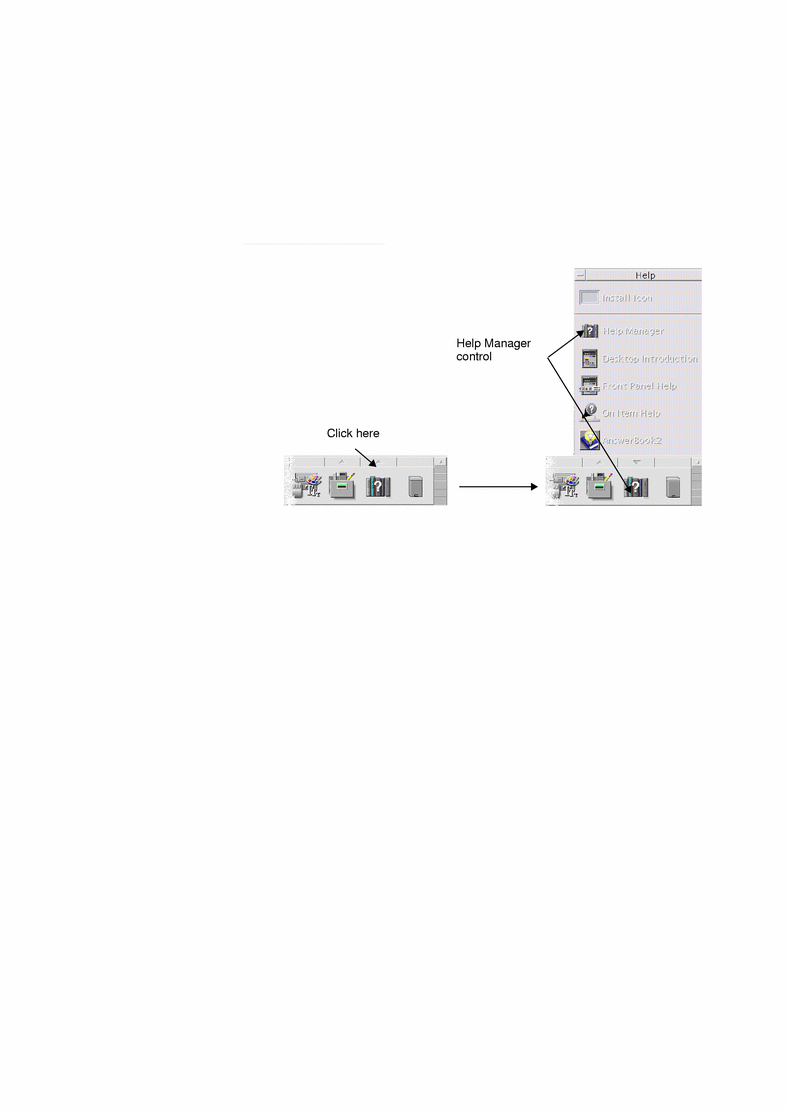
Subpanels always contain:
-
An Install Icon control. Use this control to customize the subpanel.
-
A labelled copy of the control in the Main Panel.
The Workspace Switch
The workspace switch contains the buttons you use to change from one workspace to another. The workspace switch also contains several controls.

Each workspace occupies the entire display, as though your display has several layers. Workspaces multiply the amount of display area available for windows.
Basic Front Panel Skills
This section covers basic skills for using Front Panel controls and subpanels.
To Activate a Front Panel Control
Click or double-click the control.
Some controls do not have a click action--for example, the Clock control and the busy light.
To Open a Subpanel
Controls that have subpanels have an arrow button on top of the control.
Click the arrow button above the control.
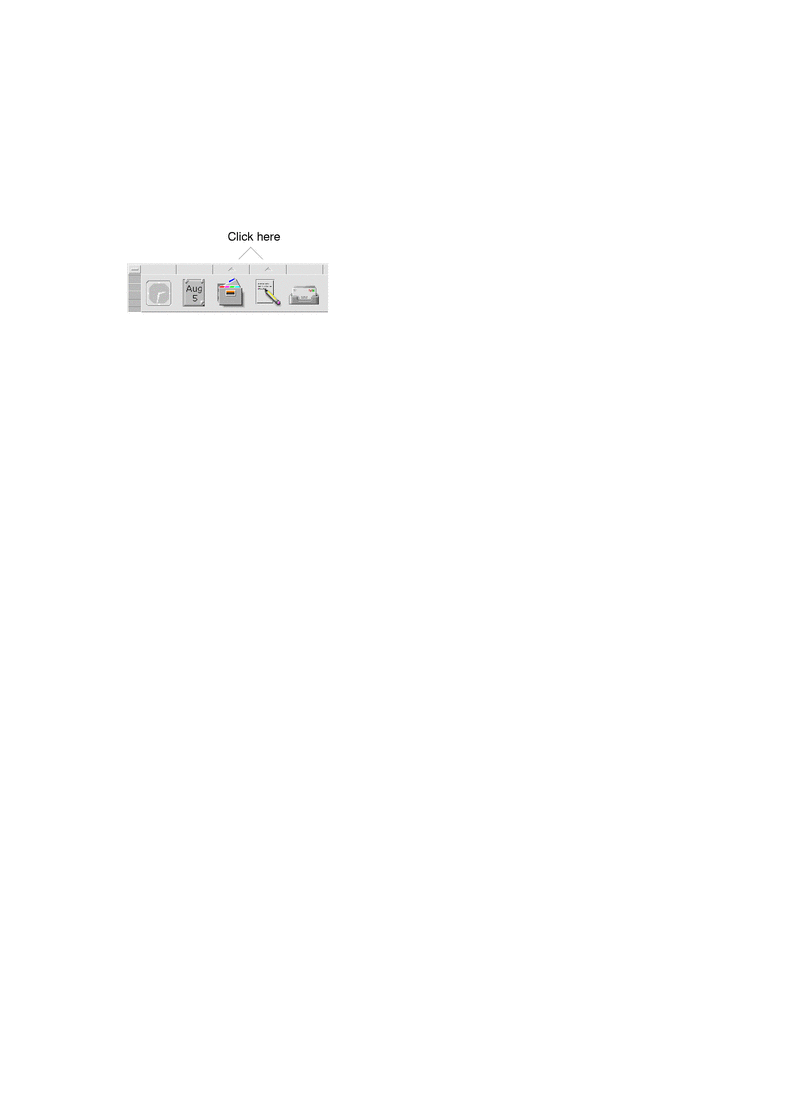
To Close a Subpanel
The subpanel closes automatically when you choose a control unless you have moved the subpanel from its original location.
-
Click the arrow control for the subpanel.
-
Or, double-click the window button in the upper left corner of the subpanel
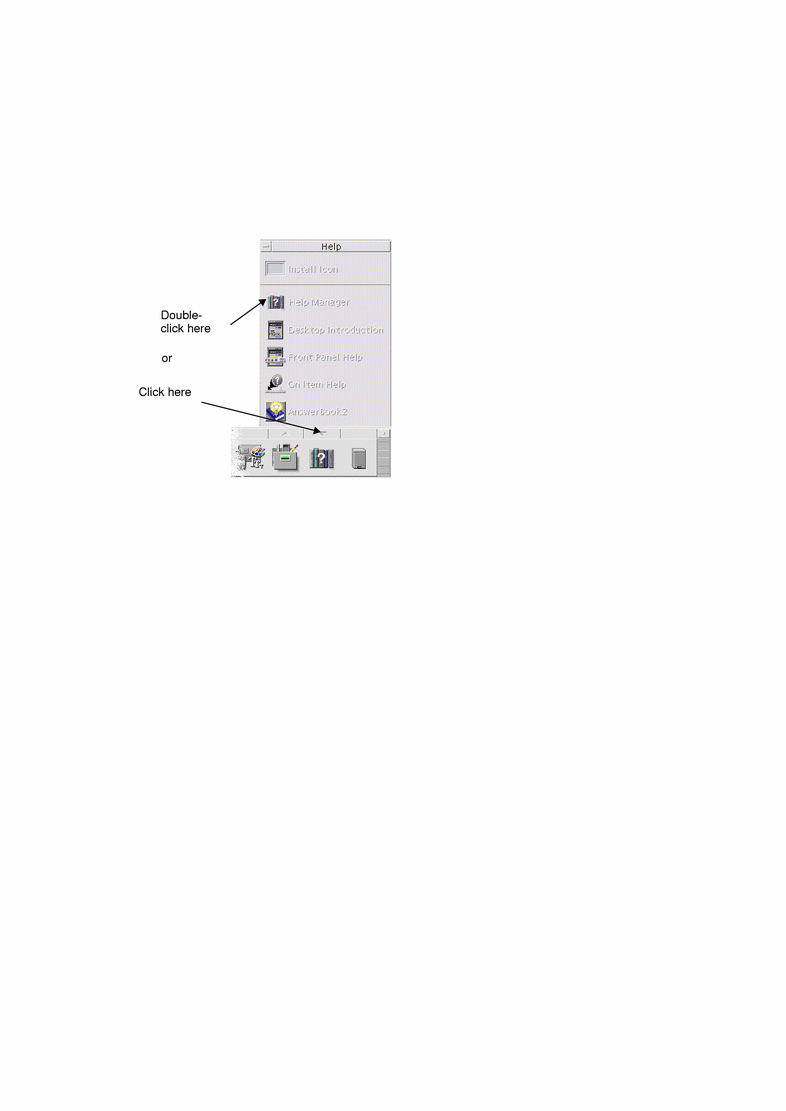
Front Panel Pop-Up Menus
Each control in the Front Panel has a pop-up menu. The menu is different for each control.
To Display a Front Panel Pop-Up Menu
Contents of the Pop-Up Menus
The contents of the pop-up menu depend on the behavior of the control and its location.
Main Panel Controls
If the control starts an application, the first entry in the menu is a command that starts the application. Choosing the menu item has the same effect as clicking the control.
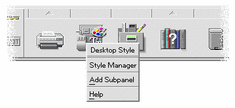
In addition, the pop-up menu may contain these items:
Add Subpanel--adds a subpanel to the control
Delete Subpanel--removes the subpanel and its contents
Help--displays On Item help for the control
Switch Area
The switch area is the portion of the workspace switch not occupied by other controls or workspace buttons.

The switch area pop-up menu contains these items:
Add Workspace--adds a workspace and creates a workspace button in the workspace switch
Help--displays help for the workspace switch
Workspace Buttons
Use the workspace buttons to change workspaces. Each button has its own menu.
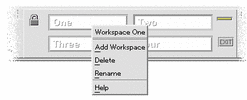
The workspace button pop-up menu includes these items:
Add Workspace--adds a workspace to your list of workspaces
Delete--deletes the workspace
Rename--changes the button into a text field for editing the name
Help--displays help for the workspace switch
Subpanel Controls
The pop-up menus for subpanels include a command for making the control the current Main Panel control.
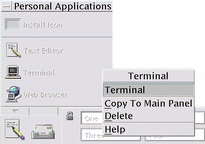
The pop-up menu for subpanel controls includes these items:
Copy to Main Panel--duplicates the control in the Main Panel, replacing the current Main Panel control
Delete--deletes the control from the subpanel
Help--displays On Item help for the control
Front Panel Help
You can get help on:
-
Individual controls
-
Using and configuring the Front Panel
To Get On Item Help on a Front Panel Control
Choose Help from the control's pop-up menu.
Or:
-
Display the Help subpanel.
-
Click the On Item Help control.
The pointer changes shape.
-
Click the control on which you want help.
To Get Help on Using and Configuring the Front Panel
-
Display the Help subpanel.
-
Click the Front Panel Help control.
This displays the Help Viewer and Front Panel help volume.
To Move the Front Panel or a Subpanel
Subpanels are moved like other windows--by dragging the title bar.
The Main Panel is moved using its move handles.

To Minimize the Front Panel
Minimizing the Front Panel turns it into an icon.
Click the Front Panel's minimize button.
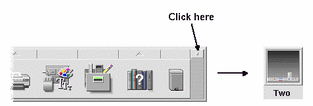
The Front Panel window icon is labeled with the workspace name.
Tour of the Front Panel
This section introduces the contents of the Main Panel and the subpanels:
-
Folders subpanel
-
Personal Applications subpanel
-
Personal Printers subpanel
-
Applications subpanel
-
Help subpanel
Your Front Panel may be customized with different or additional controls.
Main Panel
The Main Panel is the horizontal window at the bottom of the display
Table 4-1 describes the Main Panel controls.
Table 4-1 Main Panel Controls|
|
Name |
Click Behavior |
Drop Behavior |
Indicator Behavior |
|---|---|---|---|---|
|
|
None |
None |
Current time of day |
|
|
|
Starts the desktop Calendar application |
Dropping an appointment file adds the appointment to the calendar |
Current date |
|
|
|
(File Manager) |
Opens a File Manager view of your home folder |
Dropping a folder opens a File Manager view of that folder |
None |
|
|
Starts the desktop Text Editor application |
Opens the file in a new Text Editor window |
None |
|
|
|
Starts the desktop Mailer application |
Opens the contents of the file in Mailer's New Message window |
Changes appearance when new mail arrives |
|
|
|
Locks the display and keyboard. You must type your password to unlock the system. |
None |
None |
|
|
|
Workspace switch |
Changes workspaces |
None |
Indicates current workspace |
|
|
None |
None |
Blinks when the system is running an action |
|
|
 |
Displays the status of the default printer |
Prints the file on the printer |
None |
|
|
|
Begins logout from the current session |
None |
None |
|
|
|
Opens the desktop Style Manager application |
None |
None |
|
|
|
Opens an Application Manager window |
None |
None |
|
|
 |
Opens a Help Viewer window displaying the top level of help information |
Dropping a master volume file (*.sdl) opens a Help Viewer window with that help volume |
None |
|
|
|
Opens the Trash Can window |
Moves the file to the Trash Can |
Different appearance when empty and non-empty |
Folders Subpanel
Use the File Manager subpanel to access your home folder or to open a floppy diskette or CD-ROM that you have inserted into a disk drive.
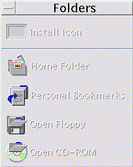
The following table describes the File Manager subpanel controls:
Table 4-2 Folders Subpanel Controls|
|
Name |
Click Behavior |
Drop Behavior |
Indicator Behavior |
|---|---|---|---|---|
|
 |
Install Icon |
None |
Installs an icon dragged from File Manger or Application Manager into the subpanel |
None |
|
|
Home Folder |
Opens your home folder displaying the top level file and folder information |
Opens a File Manager view of the dropped folder |
None |
|
|
Personal Bookmarks |
Opens your Personal Bookmarks folder displaying bookmarks |
Dropping text onto the control creates a file with a .url extension in the Personal Bookmarks folder |
None |
|
|
Open Floppy |
Opens one File Manager window for each readable floppy diskette you insert |
None |
Not Applicable |
|
|
Open CD-ROM |
Opens a File Manager window for each CD-ROM you insert |
None |
Not Applicable |
Personal Applications Subpanel
Use the Personal Applications subpanel for applications you use frequently. The default applications are Text Editor, Terminal, and Icon Editor.
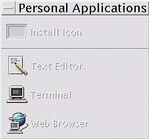
The following table describes the Personal Applications subpanel controls.
Table 4-3 Personal Applications Subpanel Controls|
|
Name |
Click Behavior |
Drop Behavior |
Indicator Behavior |
|---|---|---|---|---|
 |
None |
Installs an icon dragged from File Manger or Application Manager into the subpanel |
None |
|
|
Starts the desktop Text Editor application |
Opens the file in a new Text Editor window |
None |
||
|
|
Starts the desktop Terminal Emulator |
None |
None |
|
|
|
Starts the HotJava web browser if PATH contains the hotjava command |
None |
None |
Personal Printers Subpanel
Use the Personal Printers subpanel for printers you use frequently.
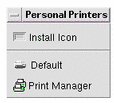
The following table describes the Personal Printers subpanel controls.
Table 4-4 Personal Printers Subpanel Controls|
|
Name |
Click Behavior |
Drop Behavior |
Indicator Behavior |
|---|---|---|---|---|
|
 |
None |
Installs an icon dragged from File Manger or Application Manager into the subpanel |
None |
|
|
|
Display the status of print jobs on the default printer |
Prints the file on the default printer or another printer of your choice |
None |
|
|
|
Starts the desktop Print Manager |
Prints the file on the default printer |
None |
Applications Subpanel
Use the Applications subpanel for system applications and tools you use frequently.
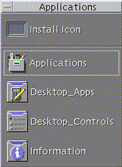
The following table describes the Applications subpanel controls.
Table 4-5 Applications Subpanel Controls|
Icon |
Name |
Click Behavior |
Drop Behavior |
Indicator Behavior |
|---|---|---|---|---|
|
|
Install Icon |
None |
Installs an icon dragged from File Manger or Application Manager into the subpanel |
None |
|
|
Applications |
Opens an Application Manager window |
None |
None |
|
|
Desktop_Apps |
Opens the Desktop_Apps folder |
None |
None |
|
|
Desktop_Controls |
Opens the Desktop_Controls folder |
None |
None |
|
|
Information |
Opens the Information folder |
None |
None |
Help Subpanel
The Help subpanel enables you to access the Help Manager, Desktop Introduction, and Front Panel help volumes, and On Item help and AnswerBook2.

The following table describes the Help subpanel controls.
Table 4-6 Help Subpanel Controls|
|
Name |
Click Behavior |
Drop Behavior |
Indicator Behavior |
|---|---|---|---|---|
|
|
Install Icon |
None |
Installs an icon dragged from File Manager or Application Manager into the subpanel |
None |
|
|
Opens a Help Viewer window displaying the top level of help information |
Dropping a master volume file (*.sdl) opens that help volume |
None |
|
|
|
Displays the help volume "Introducing the Desktop" |
None |
None |
|
|
|
Displays the Front Panel help volume |
None |
None |
|
|
|
Provides on-item help for the Front Panel. Click this control, then click the control on which you want help. |
None |
None |
|
|
|
AnswerBook2 |
Displays AnswerBook2 viewer if you have AnswerBook2 installed. |
None |
None |
Using the Web Browser
The Personal Applications subpanel of the Front Panel contains a Web Browser control. When you click the control, your PATH environment is searched for the netscape command (for the Netscape browser) or hotjava command (for the HotJava browser).
If the netscape command is found, the Netscape browser is launched. If the hotjava command is found, the HotJava browser is launched. If neither is found, an error dialog box appears reporting the failure to find a browser.
The SdtWebClient action is used to launch your system's default web browser. If you want to ensure that the default is always Netscape, change
MAP_ACTION SDtWebClient |
to
MAP_ACTION SDtNetscape |
in your user-prefs.dt file.
If you want to ensure that the default is always HotJava, change
MAP_ACTION SDtWebClient |
to
MAP_ACTION SDtHotJava |
in your user-prefs.dt file.
The user-prefs.dt file belongs in your <home-directory>/.dt/types directory. To create a user-prefs.dt file, copy the /usr/dt/appconfig/types/C/user-prefs.dt file and save it in your <home-directory>/.dt/types directory as user-prefs.dt.
Bookmarks
A bookmark is a file containing a Web URL, or a folder or attachment containing bookmarks. The Sample Bookmarks folder in the Application Manager Information folder contains examples of bookmarks. Clicking on a bookmark's icon brings up your default web browser with the web page displayed that is described by the bookmark URL. Double click on the index.html icon in the Sample Bookmarks folder to read about bookmarks.
Personal Bookmarks
The Folders subpanel of the Front Panel contains a Personal Bookmarks control. When you click on the control, a File Manager view appears on the desktop. It is initially empty. You can create bookmarks to put in this folder. These web URLs are then easily accessible through the Front Panel.
Creating Bookmarks
You can create bookmarks in any of the following ways:
-
Copy an existing bookmark: Use the File Manager Selected menu to copy an existing bookmark into your Personal Bookmarks folder, or hold down the Control key and drag the icon onto the opened Personal Bookmarks File Manager window or the Personal Bookmarks control on the Front Panel.
-
Drag URL text onto the Personal Bookmarks window. This creates a new file. The new file name is Untitled.url unless there is another file in your Personal Bookmarks folder with that name. In that case, a dialog box appears telling you to rename the new file.
-
Drag URL text onto the Personal Bookmarks control on the Front Panel. This creates a new file with a .url extension.
You can create a bookmark using any URL that is normally available, such as URLs with http addresses.
Sharing Bookmarks
If you drop URL text or a bookmark file or folder onto the Front Panel mail icon, a mail compose window appears with the corresponding bookmark as an attachment.
Customizing the Front Panel
There are two types of Front Panel customization:
-
Easy customization
This is customization you can do using the desktop's interface, including:
-
Adding controls to subpanels
-
Interchanging Main Panel and subpanel controls
-
Adding subpanels
-
Adding and deleting workspaces
-
Renaming workspaces
-
-
Advanced customization
This is customization that requires you to create or edit a Front Panel configuration file. For more information, see the Advanced User's and System Administration Guide.
To Put a Subpanel Control in the Main Panel
-
Point to the subpanel control you want to put in the Main Panel.
-
Choose Copy to Main Panel from the control's pop-up menu.

To Add an Application or Other Icon to a Subpanel
You can add any type of File Manager or Application Manager icon to the Front Panel. However, the most convenient use for this feature is adding application icons.
-
Display the object's icon in File Manager or Application Manager.
-
Display the subpanel to which the object is to be added.
-
Drag the object to the Install Icon control and drop it on the control.
How Installed Icons Work
The behavior of controls added to the Front Panel using the Install Icon control depend on the type of icon that was dropped.
File --the same behavior as the file's icon in File Manager
Folder--opens a File Manager view of the folder
Application group--opens an Application Manager view of the application group
Application icon--the same behavior as the application's icon in File Manager or Application Manager
Adding and Removing Subpanels
Any control in the Main Panel can have a subpanel.
To Add a Subpanel
-
Point to a control in the Main Panel that does not have a subpanel.
-
Choose Add Subpanel from the control's pop-up menu.
To Remove a Subpanel
To Replace a Control in the Main Panel
The easiest way to replace a control in the Main Panel is to exchange it with a subpanel control. If the control does not have a subpanel, you can create one temporarily or permanently.
-
If the control you want to replace does not have a subpanel, create one by choosing Add Subpanel from the control's pop-up menu.
-
Display the new subpanel.
-
If the control you want to put in the Main Panel is not already in the subpanel, add it to the subpanel.
-
Choose Copy to Main Panel from the subpanel control's pop-up menu.
To Remove All User Customizations
Note -
This procedure does not affect advanced customizations made by manually editing Front Panel configuration files.
-
Open Application Manager and double-click the Desktop_Tools application group icon.
-
Double-click Restore Front Panel.
The screen will go blank for several seconds while the Workspace Manager is restarted.
The Restore Front Panel action removes all customization made using:
-
The Install Icon control
-
The Front Panel's pop-up menus
-
Customizing Workspaces
You can use the Front Panel workspace switch to rename workspaces and change the number of workspaces.
To Rename a Workspace
-
Point to the workspace button of the workspace you want to rename.
-
Choose Rename from the button's pop-up menu (displayed by presssing Shift+F10 or mouse button 3).
The workspace button turns into a text field.
-
Edit the text field.
-
Press Return.
To Add Workspaces
-
Point to any area in the workspace switch and press mouse button 3 to display the pop-up menu.
-
Choose Add Workspace from the pop-up menu.
The new workspace, named New, is placed at the end of the set of workspaces.
-
Rename the workspace (see "To Rename a Workspace" above).
To Remove Workspaces
If you remove a workspace that contains windows, those windows are moved to the next workspace.
-
Point to the workspace button of the workspace you want to remove.
-
Choose Delete from the button's pop-up menu (displayed by presssing Shift+F10 or mouse button 3).
To Customize the Controls in the Workspace Switch
This is an advanced task that requires you to create a Front Panel configuration file. Advanced customization is covered in Advanced User's and System Administrator's Guide.
Initially, the workspace switch has the four positions shown below.
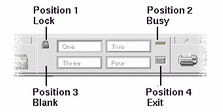
Use this procedure to replace one of these controls. (Blank is also a control.)
-
Install the application you want placed in the switch into the Personal Applications subpanel.
For example, if you want to add a Display System Load control to the switch, drag it from the Desktop_Tools application group to the Personal Applications subpanel.
-
Locate the Front Panel configuration file created automatically when you installed the control in the Personal Applications subpanel. The definition is located in the directory HomeDirectory/.dt/types/fp_dynamic.
For example, when Display System Load is added to the Personal Applications subpanel, it creates the file Xload1.fp.
-
Move the file from the HomeDirectory/.dt/types/fp_dynamic directory to the HomeDirectory/.dt/types directory.
-
Open the file in the HomeDirectory/.dt/types directory for editing.
Edit the lines that define the CONTAINER_TYPE and CONTAINER_NAME to the following:
CONTAINER_TYPE SWITCH CONTAINER_NAME Switch
-
Edit the line that defines the position (POSITION_HINTS). For example, to put the control in the Blank location, set:
POSITION_HINTS 3
-
Save the configuration file.
-
Create another file in the HomeDirectory/.dt/types directory.
The file name must end with .fp. For example. you might create a new file HomeDirectory/.dt/types/DeleteBlank.fp.
-
Open the file for editing.
-
Open the file /usr/dt/appconfig/types/language/dtwm.fp in another editor window.
This file is read-only. You will not have to write to it.
-
In /usr/dt/appconfig/types/language/dtwm.fp, find the definition for the switch control you are replacing.
For example, this is the definition for the Blank control:
CONTROL Blank { TYPE blank CONTAINER_NAME Switch CONTAINER_TYPE SWITCH POSITION_HINTS 3 ICON FpblnkS HELP_TOPIC FPOnItemSwitch HELP_VOLUME FPanel } -
Copy the definition for the control you are replacing from /usr/dt/appconfig/types/language/dtwm.fp to the new configuration file.
For example, you would copy the definition for the Blank control to the new file HomeDirectory/.dt/types/DeleteBlank.fp.
-
Add the line DELETE True to the end of the definition, within the curly braces:
CONTROL Blank { ... HELP_VOLUME FPanel DELETE True } -
Save the file.
-
Choose Restart Workspace Manager from the Workspace menu.
- © 2010, Oracle Corporation and/or its affiliates
